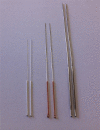Impact of Needle Diameter on Long-Term Dry Needling Treatment of Chronic Lumbar Myofascial Pain Syndrome
- PMID: 27333534
- PMCID: PMC4902326
- DOI: 10.1097/PHM.0000000000000401
Impact of Needle Diameter on Long-Term Dry Needling Treatment of Chronic Lumbar Myofascial Pain Syndrome
Abstract
Objective: To investigate the impact of diameter of needles on the effect of dry needling treatment of chronic lumbar myofascial pain syndrome.
Design: Forty-eight patients with chronic lumbar myofascial pain syndrome were randomly allocated to 3 groups. They received dry needling with needles of diameter 0.25 (group A), 0.5 (group B), and 0.9 mm (group C). Visual analog scale evaluation and health survey were conducted at baseline and 3 months after the treatment.
Results: Visual analog scale scores were significantly different in all groups from baseline to 3 months. Visual analog scale scores at 3 months showed differences between group C and the other 2 groups. When baseline and 3 months after treatment (0 day and 3 months) in each of the 3 groups was compared, there was a difference between group C and group B. The Short Form (36) Health Survey scores from baseline to 3 months were different within the treatment groups.
Conclusions: Visual analog scale score evaluations at 3 months showed efficacy in all groups. Results of 3 months showed that efficacy of treatment with larger needles (0.9-mm diameter) was better than that of smaller ones (0.5-mm diameter). The Short Form (36) Health Survey scores at 3 months indicated that treatments with needles of varying diameters were all effective, and when the results of 3 months were compared, there was no difference between the 3 groups.
Figures





References
-
- Malanga GA, Cruz Colon EJ: Myofascial low back pain: a review. Phys Med Rehabil Clin N Am 2010;21:711–24 - PubMed
-
- Fishbain DA, Goldberg M, Meagher BR, et al. Male and female chronic pain patients categorized by DSM-III psychiatric diagnostic criteria. Pain 1986;26:181–97 - PubMed
-
- Tough EA, White AR, Richards S, et al. Variability of criteria used to diagnose myofascial trigger point pain syndrome—evidence from a review of the literature. Clin J Pain 2007;23:278–86 - PubMed
-
- Hong CZ: Lidocaine injection versus dry needling to myofascial trigger point. The importance of the local twitch response. Am J Phys Med Rehabil 1994;73:256–63 - PubMed
-
- Vedolin GM, Lobato VV, Conti PC, et al. The impact of stress and anxiety on the pressure pain threshold of myofascial pain patients. J Oral Rehabil 2009;36:313–21 - PubMed
Publication types
MeSH terms
LinkOut - more resources
Full Text Sources
Other Literature Sources
Medical

